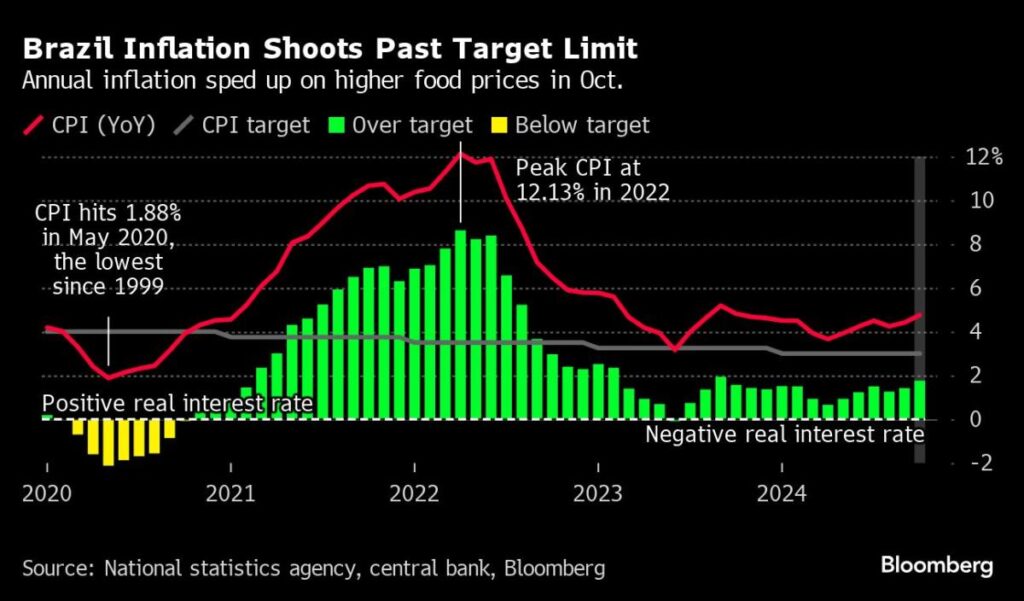In October, Brazil’s inflation surged past the upper limit of the central bank’s tolerance range, highlighting the continuing economic heat in Latin America’s largest economy. Official data showed that consumer prices rose by 4.76% year-over-year, exceeding the median estimate of 4.74% from analysts surveyed by Bloomberg, and surpassing the 4.5% upper threshold for acceptable inflation levels. Monthly inflation figures also revealed a 0.56% increase. Such trends prompted the central bank to accelerate its rate hike strategy, as the economic landscape is characterized by strong growth coupled with an unemployment rate at historically low levels. This robust economic performance is, however, juxtaposed with rising concerns over fiscal policies under President Luiz Inácio Lula da Silva, whose administration has been associated with increasing public spending that may contribute further to inflationary pressures.
Contributing to Brazil’s inflationary situation are ongoing supply-side challenges, notably a historic drought that has devastated agricultural output and exerted upward pressure on energy prices. The increased cost of energy is a critical factor as it feeds directly into consumer prices, exacerbating the inflation problem. Moreover, the Brazilian real has depreciated over 15% against the US dollar this year, which could further elevate import costs and solidify inflationary trends. The combined effect of currency depreciation and rising domestic prices fundamentally complicates the central bank’s attempts to rein in inflation to its target rate of 3%.
In light of these economic challenges, Brazil’s central bank has been forced to adapt its monetary policy by ramping up interest rate increases. As inflation forecasts continue to rise due to mounting fiscal pressures, policymakers are intensifying their focus on maintaining price stability. The current situation emphasizes the trade-off between sustaining economic growth and controlling inflation, which has become increasingly precarious. The balance is further strained by Lula’s economic policies, which have spotlighted the fiscal gap and growing public deficits, necessitating strategic budget cuts to stabilize the country’s finances and potentially curb inflation.
Potential external factors could further impact Brazil’s economy. The recent reelection of Donald Trump, who has indicated intentions of deregulating and imposing tariffs on trade partners, could put additional pressure on the Brazilian economy. Such policies may lead to increased volatility in foreign exchange rates, impacting the real even more as the domestic economy seeks to navigate its fiscal challenges. Lula’s administration has recognized the need to address these pressures through a series of proposed budget cuts, aiming to bolster public accounts while mitigating the risks to the currency.
Amid these complexities, Brazil’s economic landscape remains fraught with challenges and opportunities. The central bank’s proactive approach in raising interest rates reflects its commitment to combat inflation while striving to support economic stability. However, the overarching influence of external events, particularly in the context of global trade dynamics, poses a significant threat to Brazil’s ongoing recovery from previous economic slowdowns. The interplay between domestic fiscal measures and international market conditions will be critical in determining the trajectory of Brazil’s economic landscape moving forward.
As Brazil navigates through this economic environment, the convergence of internal and external factors will play a decisive role. The blend of rising inflation, currency volatility, and fiscal management under Lula’s government will likely shape investor confidence and the broader economic outlook. While the central bank’s monetary policy adjustments are intended to stabilize prices, the complexity of the situation underscores the interplay of various economic forces that Brazil must contend with as it seeks to secure sustainable growth in the future.

